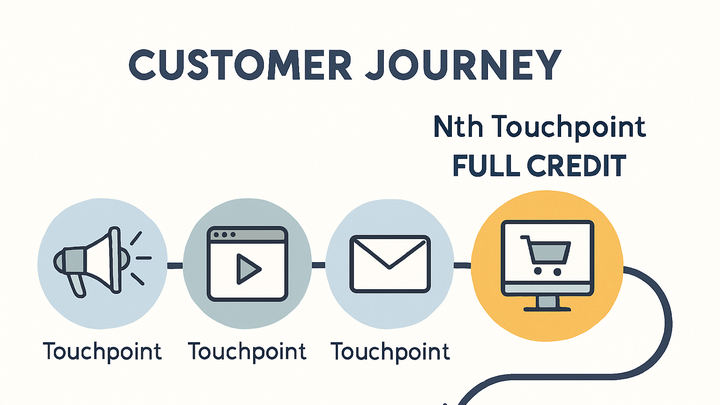Published on 2025-06-22T04:02:52Z
What is Nth Touch Attribution? Examples for Nth Touch Attribution.
Nth Touch Attribution is an attribution model used in marketing analytics to assign credit to the Nth interaction or touchpoint in the customer journey. Unlike first-touch or last-touch models which attribute all value to the first or last interaction, Nth Touch Attribution allows marketers to select any position (Nth) in the sequence to evaluate the impact of a specific touchpoint. This approach offers flexibility to emphasize mid-funnel channels or critical engagements that align with business objectives. However, it requires robust, timestamped event data and careful selection of N to avoid oversimplification. SaaS analytics tools like Google Analytics 4 (GA4) and privacy-focused PlainSignal can be configured to implement Nth Touch Attribution, each with its own setup and considerations.
Nth touch attribution
Attribution model assigning credit to the Nth touchpoint in a customer journey.
Definition and Importance
Understanding what Nth Touch Attribution is and why it matters in marketing analytics frameworks.
-
What it is
Nth Touch Attribution assigns full credit for a conversion to the Nth interaction in a user’s path to purchase or sign-up, which can be any position such as 1st, 2nd, 3rd, etc.
-
Why it matters
This model allows marketers to focus on critical touchpoints beyond just the first or last interactions, providing insights into mid-funnel engagement and optimizing key channels.
-
Mid-funnel optimization
Highlights the impact of remarketing emails, retargeting ads, or content engagement that often occur in the middle of the customer journey.
-
Tailored insights
Enables selection of N to align with specific campaign goals, such as crediting the third ad click or second email open.
-
How Nth Touch Attribution Works
Dive into the mechanics of selecting and crediting the Nth touchpoint using timestamped analytics data.
-
Attribution position (n)
Marketers specify which touchpoint position (e.g., 3rd interaction) should receive credit, based on typical customer journey length and business priorities.
-
Selecting n
Choose N by analyzing average path length, campaign structure, and which channel interaction drives the most influence.
-
-
Data requirements
Accurate, timestamped recording of each touchpoint across marketing channels is essential for correctly identifying the Nth interaction.
-
Tracking methods
Leverage cookies, first-party tracking (e.g., PlainSignal), and event-based tracking (e.g., GA4) to capture user interactions.
-
Cross-device stitching
Ensure sessions and events are unified across devices and browsers to avoid misattribution.
-
-
Credit allocation
All conversion credit is assigned exclusively to the Nth touch; all other touchpoints receive no credit in this model.
Example Implementation with SaaS Products
Step-by-step examples of configuring Nth Touch Attribution in PlainSignal and Google Analytics 4 (GA4).
-
PlainSignal (cookie-free simple analytics)
Use PlainSignal’s lightweight JavaScript snippet to collect first-party events and configure an Nth Touch report in its dashboard.
-
Tracking code snippet
<link rel='preconnect' href='//eu.plainsignal.com/' crossorigin /> <script defer data-do='yourwebsitedomain.com' data-id='0GQV1xmtzQQ' data-api='//eu.plainsignal.com' src='//cdn.plainsignal.com/plainsignal-min.js'></script> -
Configuration
In the PlainSignal dashboard, navigate to Attribution → Create New → Select ‘Nth Touch’ → Enter your desired N (e.g., 3) → Apply filters.
-
Considerations
As a cookie-free solution, PlainSignal relies on first-party signals; ensure consistent domain tagging for accurate cross-site tracking.
-
-
Google analytics 4 (GA4)
Although GA4 does not natively offer Nth Touch Attribution, you can build custom reports or use BigQuery for sequence modeling.
-
Setup in GA4
In GA4 Admin, go to Attribution Settings to review models; for Nth Touch, export data to Data Studio or BigQuery.
-
Gtag.js snippet
<script async src='https://www.googletagmanager.com/gtag/js?id=G-XXXXXX'></script> <script> window.dataLayer = window.dataLayer || []; function gtag(){dataLayer.push(arguments);} gtag('js', new Date()); gtag('config','G-XXXXXX'); </script> -
Custom modeling
Use GA4’s BigQuery export: write SQL to order events by timestamp per user, identify the Nth event, and assign conversion credit.
-
Advantages and Limitations
Assess the benefits and drawbacks of using Nth Touch Attribution in your analytics strategy.
-
Advantages
Provides targeted insights into specific journey stages, avoids over-crediting first or last interactions, and can be tailored to campaign objectives.
-
Limitations
Ignores other touchpoints, may oversimplify multi-channel influence, and demands high-quality, unified data across devices.
Best Practices
Tips to maximize the effectiveness of Nth Touch Attribution.
-
Choose the right n
Analyze typical customer journey lengths and select an N that aligns with key engagement milestones.
-
Validate with multiple models
Compare Nth Touch results against first-touch, last-touch, and multi-touch models to gain a holistic understanding.
-
Ensure data quality
Implement consistent event naming, robust cross-domain tracking, and merging of duplicate user identifiers.
